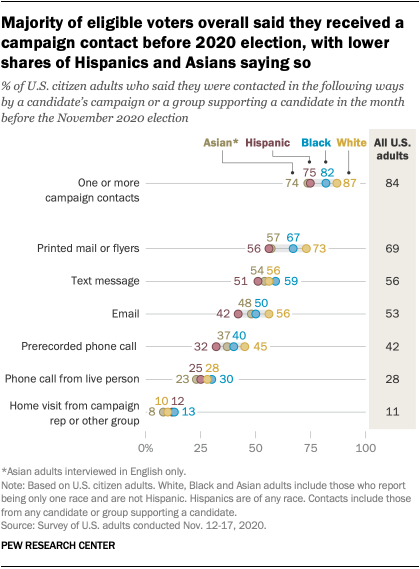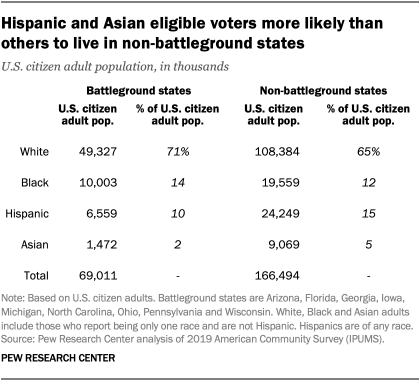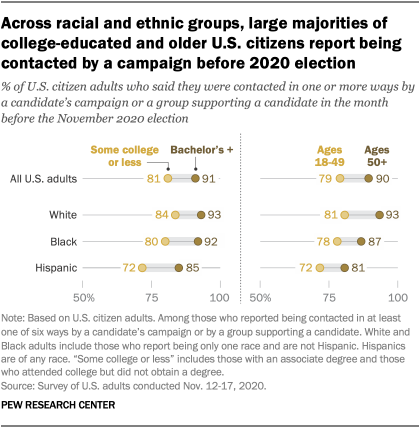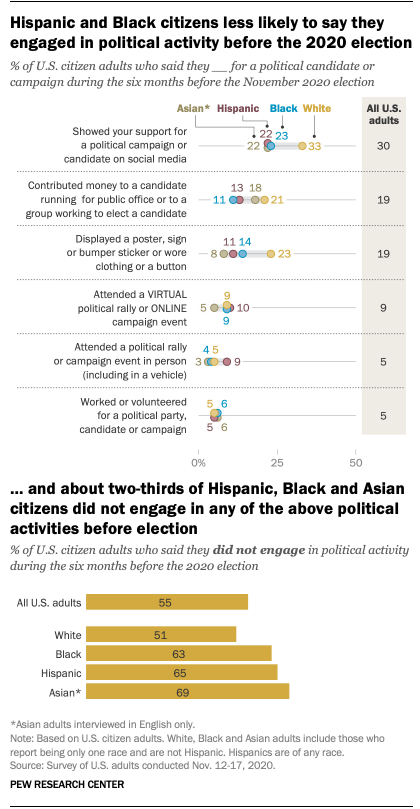Most U.S. adults said they were contacted by a candidate’s campaign or a group supporting a candidate in the month before the November 2020 presidential election, with majorities saying so across racial and ethnic, educational, age and partisan groups. But when it came to Latino and Asian citizens, lower shares of those groups reported a campaign contact than adult U.S. citizens overall, according to a Pew Research Center survey conducted in the days after the election.
Overall, 84% of U.S. adults who are citizens, and therefore eligible to vote, said they were contacted by a candidate’s campaign or by a group supporting a candidate in at least one of six ways in the month before the November 2020 election. White eligible voters (87%) were somewhat more likely to say they were contacted than Black (82%), Hispanic (75%) or English-speaking Asian (74%) eligible voters, according to the survey. This pattern largely held true even when statistically controlling for other factors such as gender, age, education and party affiliation.
U.S. citizen adults said they were contacted in a variety of ways before the 2020 election, with printed mail the most common type of campaign outreach reported. About three-quarters of White eligible voters (73%) said they were contacted in this way, as did 67% of Black, 57% of English-speaking Asian and 56% of Latino eligible voters.
This analysis sought to track political campaign outreach and voter engagement for the 2020 election. It draws on a Pew Research Center survey of 11,818 U.S. adults conducted Nov. 12-17, 2020, including 11,366 adults who are U.S. citizens.
Everyone who took part is a member of the Center’s American Trends Panel (ATP), an online survey panel that is recruited through national, random sampling of residential addresses. This way nearly all U.S. adults have a chance of selection. The survey is weighted to be representative of the U.S. adult population by gender, race, ethnicity, partisan affiliation, education and other categories. Read more about the ATP’s methodology.
Here are the questions used for this report, along with responses, and its methodology.
Estimates of how many citizens in each group lived in battleground states are from a Pew Research Center analysis of the 2019 American Community Survey (IPUMS).
Text messages (56%) and email (53%) were the next most common forms of campaign outreach overall, with a slim majority of U.S. citizen adults saying they received a campaign message by one of these methods. About half or more of U.S. citizens across racial and ethnic groups said they received a campaign contact via text message. Meanwhile, a slightly lower share of Hispanic (42%) and Black (50%) eligible voters reported receiving a campaign email than did White eligible voters (56%). About half of Asian eligible voters (48%) said the same.
Among those who said they voted in the 2020 election, about nine-in-ten adults reported receiving one more campaign contacts, a higher share than among all citizens (83%). This pattern extended across most racial and ethnic groups.
A prior analysis found that the amount of campaign outreach received by those who reported voting is associated with their level of political activism, with those who are more politically active saying they received more types of contacts (though survey respondents may not be aware of all campaign contacts they received).
Hispanics and Asians make up a growing share of the nation’s eligible voters. At the same time, voter turnout among Hispanic and Asian eligible voters typically trails that of White and Black eligible voters. This remained true in 2018 even after a surge in turnout nationwide. Voter turnout in 2020 is scheduled to be published by the U.S. Census Bureau later this year.
A survey fielded just before the election found mixed interest in the presidential campaign among Hispanics, views that came amid concerns the Biden campaign could have done more to engage earlier with potential Hispanic voters. Concerns were also voiced about a lack of outreach to prospective Asian American voters.
A higher share of U.S. citizen adults living in nine presidential battleground states reported receiving at least one campaign contact than did those living in non-battleground states, 93% vs. 80%.
Latinos and Asian Americans accounted for a lower share of U.S. citizen adults in battleground states (10% and 2%) than non-battleground states (15% and 5%), according to an analysis of Census Bureau data. By contrast, White and Black Americans accounted for a higher share of eligible voters in battleground states (71% and 14%) than non-battleground states (65% and 12%).
It’s also worth noting that among Latino and Asian citizens, a significant share of the population is not proficient in English, according to Census Bureau data. Eight-in-ten Latino eligible voters (80%) say they speak only English or speak English very well, while 71% of Asian eligible voters say the same. By contrast, higher shares of White (99%) and Black (98%) eligible voters say the same.
U.S. eligible voters with a college degree and those ages 50 and older more likely to report campaign contact
Among U.S. citizen adults, a larger share with a bachelor’s degree or higher reported being contacted in at least one of six ways than did those with some college education or less, 91% vs. 81%. These differences extend to Black (92% vs. 80%), Hispanic (85% vs. 72%) and White (93% vs. 84%) eligible voters.
Adults ages 50 and older are more likely than those 18 to 49 to say they were contacted by a campaign, 90% vs. 79%. Differences by age were also reported among racial and ethnic groups, including among Black (87% vs. 78%) and White (93% vs. 81%) eligible voters. (The sample of Asian eligible voters was too small to analyze by education and age.)
Notably, the share of adults who said they received at least one campaign contact did not differ substantially between Democrats and Democratic-leaning independents (87%) and Republicans and Republican-leaning independents (85%). Men and women, 83% vs. 85%, also had similar shares of contact by a campaign.
Posting online was the most common preelection political activity among eligible voters
In the six months before the November election, about three-in-ten U.S. citizen adults reported they showed support for a political campaign or candidate on social media – the most common preelection political activity overall. Across racial and ethnic groups, Black (23%), Hispanic (22%) and Asian (22%) eligible voters were less likely than White eligible voters (33%) to say they posted a political message online in the six months before the election.
The next most common preelection activities were making a financial contribution in support of a candidate (19%) and displaying a poster in support of a campaign (19%). Latino (13%) and Black (11%) eligible voters were less likely than White (21%) eligible voters to say they contributed money to a candidate running for public office or to a group working to elect a candidate. Meanwhile, a lower share of Black (14%), Hispanic (11%) and Asian (8%) eligible voters said they displayed a sign when compared with White eligible voters (23%).
About two-thirds of Hispanic, Black and Asian eligible voters said they did not participate in any of the six political activities asked about in the survey during the six months leading up to the election. By contrast, about half of White eligible voters said the same. Overall, a majority of U.S. citizen adults (55%) said they did not participate in a political activity.
Note: Here are the questions used for this report, along with responses, and its methodology.



